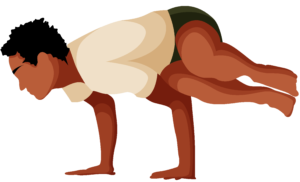Side Crane (Parsva Bakasana)
Pose Overview
| Common Name | Side Crane |
| Traditional Sanskrit Name | Parsva Bakasana |
| Sanskrit Name Pronunciation | parsh-va bahk-ah-sah-na |
| Pose Difficulty | Intermediate |
| Drishti
Drishti is the gaze or visual focus point during yoga poses.
Learn more about Drishti |
Straight ahead or the nose |
Side Crane Pose, or Parsva Bakasana in Sanskrit, is a yoga pose that is said to be beneficial for strengthening the arms, wrists and core, as well as for promoting a sense of balance and focus. The name of the pose comes from the fact that it resembles a side crane, with the body in a crouching position and the arms and legs extended. The pose is said to be helpful for increasing flexibility and strength in the arms, wrists and core, and for promoting a sense of balance and focus. It is also said to be beneficial for relieving stress and anxiety, and for promoting a sense of inner peace. This pose is also said to help to tone the arms and wrists, and to help to improve balance and stability.
Benefits of Side Crane
Strengthens the arms, wrists and core Improves balance and focus Opens the hips and chest Stimulates the digestive and reproductive systems
How to Enter Side Crane
Begin in a low lunge position with your back leg extended behind you Place your hands on the mat beside your front foot Shift your weight forward and lift your back foot off the mat Bend your arms and bring your knees to the outside of your upper arms Keep your gaze forward and lift your hips up and back Slowly lower your back heel to the mat behind you
How to Exit Side Crane
Slowly release the pose by lowering your back heel to the mat Bring your hands to the mat and step back to a low lunge
Common Side Crane Modifications & Variations
To make the pose less challenging, you can practice with your back heel on the mat To make the pose more challenging, you can lift your back heel higher and try to bring your feet closer to your head
Common Mistakes with Side Crane
Rounding the back or hunching the shoulders Placing too much weight on the hands or wrists
Safety Guidance
Make sure to engage your core and keep your back straight Avoid placing too much weight on your hands or wrists Keep your gaze forward to maintain balance

